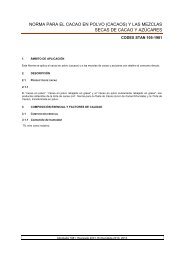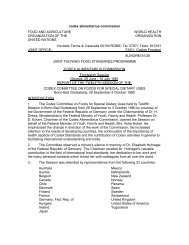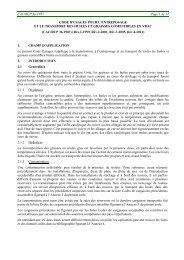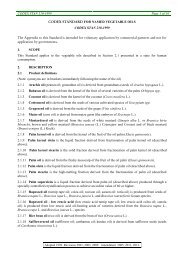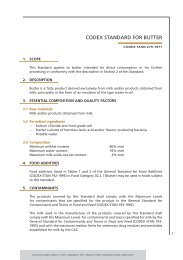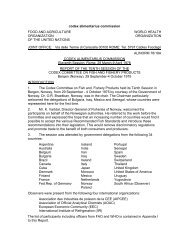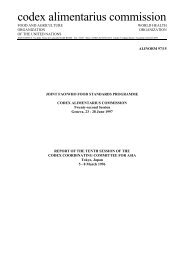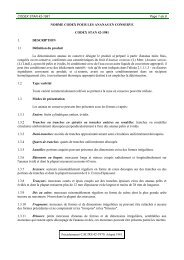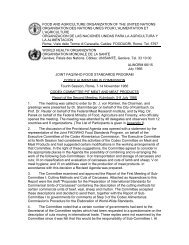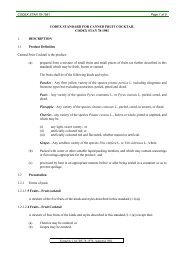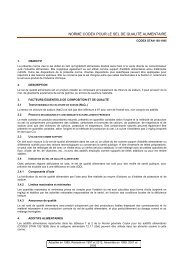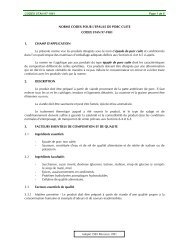REP13/FH JOINT FAO/WHO FOOD STANDARDS PROGRAMME ...
REP13/FH JOINT FAO/WHO FOOD STANDARDS PROGRAMME ...
REP13/FH JOINT FAO/WHO FOOD STANDARDS PROGRAMME ...
You also want an ePaper? Increase the reach of your titles
YUMPU automatically turns print PDFs into web optimized ePapers that Google loves.
<strong>REP13</strong>/<strong>FH</strong> Appendix II 38<br />
SECTION 7 – <strong>FOOD</strong> PREPARATION<br />
7.1 Requirements for ingredients<br />
Every vendor should ensure the following<br />
7.1.1 Supply of all raw food, other ingredients, including ice, must be from known and reputable reliable<br />
sources.<br />
7.1.2 The food handling method employed should be such as to minimize the loss of nutrients.<br />
7.1.3 Freshness and wholesomeness of ingredients to maintain quality and safety of food.<br />
7.1.4 Transportation of ingredients should be made in a manner so as to prevent exposure to the<br />
environment, spoilage and contamination.<br />
7.1.5 Only permitted food additives should be used and the amount added should follow the specifications<br />
provided.<br />
7.2 Cooking and handling<br />
7.2.1 Thoroughly wash fresh vegetables and fruit whether for cooking or consuming raw, with sufficient<br />
running potable water, to remove adhering surface contamination. For any soaking, potable water should be<br />
used.<br />
7.2.2 Where appropriate, wash raw food before using in food preparation to reduce the risk of contamination.<br />
Never wash perishable raw food with other foods that will be consumed raw or in a semi-cooked state.<br />
7.2.3 There should be an area for handling, storing, cleaning and preparing raw food ingredients, separate<br />
and apart from the cooked, street food display, handling and serving areas.<br />
7.2.4 Thawing: Frozen products, especially frozen vegetables, can be cooked without thawing. However, large<br />
pieces of meat or large poultry carcasses often need to be thawed before cooking. When thawing is carried out<br />
as an operation separated from cooking this should be performed only in:<br />
(a) a refrigerator or purpose-built thawing cabinet maintained at a temperature of 4°C; or<br />
(b) running potable water maintained at a temperature not above 21°C for a period not exceeding 4 hours;<br />
or (delete because food could be exposed to temperatures that promote microbial growth)<br />
(c) a commercial microwave oven only when the food will be immediately transferred to conventional<br />
cooking units as part of a continuous cooking process or when the entire, uninterrupted cooking<br />
process takes place in the microwave oven.<br />
NOTE: Hazards associated with thawing include cross-contamination from drip and growth of micro-organisms<br />
on the outside before the inside has thawed. Thawed meat and poultry products should be checked frequently to<br />
make sure the thawing process is complete before further processing or the processing time should be<br />
increased to take into account the temperature of the meat.<br />
7.2.5 The time and temperature of cooking should be sufficient to reduce to safe levels any pathogens that<br />
may be present in the food. ensure the destruction of non-spore forming pathogenic micro-organisms.<br />
7.2.6 Water used for the purpose of drinking, preparation of hot or cold drinks and beverages should be<br />
potable.<br />
7.2.7 Ice should be made from potable water. Ice should be handled and stored so as to protect it from<br />
contamination. Containers used to transport or store ice should meet the requirements for water containers<br />
prescribed by Section 2.3.18.<br />
7.2.8 Food should not be re-heated more than once and only the portion of the food to be served should be<br />
re-heated. A temperature of at least 75°C should be reached in the centre of the food within one hour of<br />
removing the food from refrigeration. Lower temperatures may be used for reheating providing the<br />
time/temperature combinations used are equivalent in terms of destruction of microorganisms to heating to a<br />
temperature of 75°C. (concerns over food handlers correctly using alternatives)<br />
7.2.9 Utensils used for tasting food should be washed immediately after each use.



